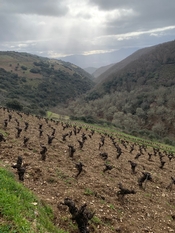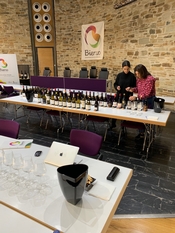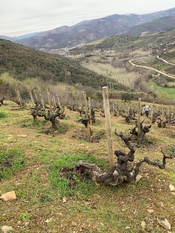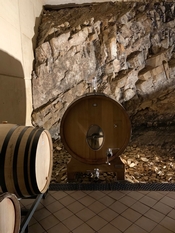I’m writing this while returning from three days of intensive tasting in Bierzo, which is also to say that I’m winding up a seven-day trip. No kidding. Bierzo is so remote that it is taking me longer to get there and back than the span I could enjoy tasting in the region, and that’s timed from the East Coast of the USA to Bierzo, which is on the western side of Spain, which is among the most westerly of all European countries.
To say that Bierzo is a remote wine region is indisputably true but also trivial, because Bierzo’s wines are so superb that they make the journey worth the effort—regardless of the rigors involved. This was my third visit to  Bierzo, and if I were invited back next week, after I’d finished my laundry and caught a bit of sleep, I’d turn around and go back.
Bierzo, and if I were invited back next week, after I’d finished my laundry and caught a bit of sleep, I’d turn around and go back.
The best reds made in Bierzo from the Mencía grape variety can measure up to any reds made from anything, anywhere. Moreover, in the years since I first visited Bierzo in 2007, the best whites made from the Godello grape variety have risen from mere curiosities, even within the region, to contenders for the title of Spain’s best white table wines.
I could certainly understand if you dismissed such high praise as overly excited verbiage from someone freshly returned from an enjoyable trip. However, the fact is that I’m writing this in a cramped Economy seat on an airplane during the fourth of four transit days—a sufficiently inglorious situation to encourage sober assessment even if my portion of the plane wasn’t occupied by a passenger with a truly astonishing case of flatulence.
Bierzo wines are every bit as good as I’ve claimed here, and though you may not have direct experience to corroborate my glowing account, you’ll find that tasting is believing once you get your chance. That may require some time and effort if you don’t live in a major metropolitan area, as the wines aren’t plentiful and aren’t yet  widely distributed in the USA. Yet the expansion of direct shipping has made direct tasting experience vastly easier than it was not long ago, and I’ll follow up this blog posting with so many tasting notes on Wine Review Online that almost everyone reading these lines will have a fighting chance with a bit of effort.
widely distributed in the USA. Yet the expansion of direct shipping has made direct tasting experience vastly easier than it was not long ago, and I’ll follow up this blog posting with so many tasting notes on Wine Review Online that almost everyone reading these lines will have a fighting chance with a bit of effort.
“Effort” is an appropriate word for emphasis in relation to Bierzo, where the best vineyard plots are often small, isolated, and so steeply inclined that simply stepping into the loose slate soil is a life-risking proposition. Just as there’s nothing easy about getting to Bierzo, there’s nothing easy about viticulture within the region, and likewise nothing easy about getting the wines out to world markets to gain the attention they deserve.
To underline that point, I’d like to paraphrase a reflection offered by a vintner over dinner a couple of nights ago. I won’t attribute what follows to the speaker by name, as I’m working from memory and a hastily scribbled note, and also because I can’t check the quote from my present location at 35,000 feet of altitude. Moreover, there’s a chance that others in Bierzo might not take kindly to a resident’s musing to a  journalist about the region’s supremely challenging remoteness at a time when Bierzo is enjoying its first little taste of limelight.
journalist about the region’s supremely challenging remoteness at a time when Bierzo is enjoying its first little taste of limelight.
My dinner companion made a striking statement, and it came “out of the blue,” as none of us at the table were talking about the Camino de Santiago. For centuries, this “Way of St. James” has been the most famous route for pilgrims in Christendom, bringing a steady stream of hardy and presumably pious hikers across northern Spain to Santiago de Compostela, where the remains of the Saint are purportedly interred all the way on the Atlantic coast. A “steady stream” is hardly a throng, and pilgrims aren’t likely to trumpet the virtues of wines they enjoyed as the most meaningful aspect of a hike that is much more about piety and pain than pleasure. But those facts make the statement all the more striking, so I’ll close with it, paraphrasing as best I can:
 exactly right. Looking ahead, though, I’d offer an observation that runs slightly to the contrary. The day is fast approaching when Bierzo will be known by hundreds of thousands of people who know nothing about the Camino, and who are aware only the distinctiveness and deliciousness of the region’s wines. And once that day has arrived, curious wine pilgrims will possibly outnumber their religious counterparts, however difficult the journey.
exactly right. Looking ahead, though, I’d offer an observation that runs slightly to the contrary. The day is fast approaching when Bierzo will be known by hundreds of thousands of people who know nothing about the Camino, and who are aware only the distinctiveness and deliciousness of the region’s wines. And once that day has arrived, curious wine pilgrims will possibly outnumber their religious counterparts, however difficult the journey. 1
